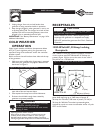
11
BSPP Generator
2. Unplug charger from unit and wall outlet when
generator is being started and while in operation.
3. Keep charger plugged in when generator is not in use
to prolong battery life.The charger has a built in float
equalizer and will not overcharge battery, even when
plugged in for an extended period of time.
IMPORTANT: See “Battery Maintenance” on page 16 for
additional information.
COLD WEATHER
OPERATION
Under certain weather conditions (temperatures below
40°F [4°C] and a high dew point), your generator may
experience icing of the carburetor and/or the crankcase
breather system.
Build a structure that will enclose three sides and the top
of the generator:
1. Make sure entire muffler-side of generator is exposed.
Note that your generator may appear different from
that shown in Figure 9.
2. Ensure a minimum of three feet clearance between
open side of box and nearest object.
3. Face exposed end away from wind and elements.
4. Enclosure should hold enough heat created by
generator to prevent problems.
RECEPTACLES
120/240 Volt AC, 30 Amp, Locking
Receptacle
Use a NEMA L14–30 plug with this receptacle. Connect a
4–wire cord set rated for 250 Volts AC at 30 Amps (or
greater) (Figure 10).You can use the same 4–wire cord if
you plan to run a 120 Volt load.
This receptacle powers 120/240 Volt AC, 60 Hz, single
phase loads requiring up to 3,600 watts of power at
30 Amps for 120 Volts; 7,200 watts of power (7.2 kW) at
30 Amps for 240 Volts.The outlet is protected against
overload by a push–to–reset circuit breaker and/or a 2 pole
GFCI circuit breaker.
• NEVER attempt to power a device requiring more
amperage than generator or receptacle can supply.
• DO NOT overload the generator. See “Don’t Overload
Generator”.
Receptacles may be marked with rating value greater
than generator output capacity.
CAUTION
Figure 9 — Permanent Cold Weather Shelter
Wind
• Operate generator ONLY outdoors.
• Keep exhaust gas from entering a confined area through
windows, doors, ventilation intakes or other openings.
• DO NOT operate generator inside any building or enclosure,
including the generator compartment of a recreational vehicle (RV).
Running generator gives off carbon monoxide,
an odorless, colorless, poison gas.
Breathing carbon monoxide will cause nausea,
fainting or death.
DANGER
Figure 10 — 120/240 Volt AC, 30 Amp Receptacle
4-Wire Cord Set
240V
120V
120V
W (Neutral)
X (Hot)
Y (Hot)
NEMA L14-30
Ground (Green)


















